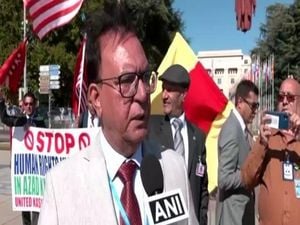On Monday, August 18, 2025, the usually tranquil city of Plattsburgh, New York, became the stage for a political drama that quickly reverberated far beyond Clinton County. North Country Congresswoman Elise Stefanik, a prominent Republican and close ally of former President Donald Trump, found herself at the center of a storm as she attempted to honor the late John Zurlo during a government building renaming ceremony. What was intended as a respectful tribute to a local public servant instead turned into a vivid display of America’s political polarization, with Stefanik being loudly booed and heckled offstage by protesters.
According to WPTZ and other local outlets, Stefanik was introduced to the podium at the Clinton County Government Center—soon to bear Zurlo’s name—but her remarks were almost immediately drowned out. A smattering of cheers was quickly overwhelmed by a chorus of boos and insults. Protesters, holding signs denouncing Stefanik’s support for several controversial Trump-backed policies, made their discontent unmistakable. Some shouted, “Traitor!” while others referenced the so-called “Big, Beautiful Bill” Act and federal funding cuts to public broadcasting, among other grievances.
Stefanik, visibly taken aback, initially walked off the stage. But she soon returned, determined to deliver her tribute. Speaking to reporters after the event, as reported by Fox News, she explained her decision: “I thought that the radicals would calm down out of respect for the Zurlo family. Obviously, they did not do that, but I was not going to let them drown out me by talking about how important it is to commemorate John Zurlo’s legacy.” She emphasized, “It was important to make sure the Zurlo family heard from me.”
The congresswoman did not mince words in her public response. In a statement posted on X (formerly Twitter), she railed against what she called “radical Far Left Democrat agitators,” declaring, “Today #NY21 witnessed shameful conduct by radical Far Left Democrat agitators who disgracefully attempted to drown out and silence a non-political event in Plattsburgh to honor the lifelong service of John Zurlo in Clinton County as the building was named in his honor.”
Stefanik’s frustration was echoed in comments to local media, including WCAX, where she said, “Today’s event was about honoring John Zurlo and it is a disgusting disgrace that this is what the far left does, rather than understanding that his family has been through a tremendous amount. It was about honoring his legacy.”
The protesters’ motivations appeared to be as varied as their signs. According to Fox News, demonstrators objected not only to Stefanik’s support for Trump’s legislative agenda—including the “Big, Beautiful Bill” and its associated tax cuts and immigration reforms—but also to her stances on Medicaid, U.S. Immigration and Customs Enforcement (ICE) deportations, and what they described as “bullying” behavior. Some signs accused Stefanik of racism, while others simply called her a “bully.”
The “Big, Beautiful Bill,” a centerpiece of Trump’s second-term agenda and celebrated by House Republicans including Speaker Mike Johnson, has been particularly contentious. While GOP leaders tout the bill’s tax cuts and immigration reforms, Democrats have criticized it for deep cuts to Medicaid. The Congressional Budget Office (CBO) projects that about 10 million more people will be uninsured by 2034 as a result of the bill—a statistic frequently cited by critics. Republicans, for their part, argue the legislation only targets waste, fraud, and abuse in Medicaid, a point hotly debated in the run-up to the 2026 midterm elections.
Stefanik’s appearance came during the August congressional recess, a time when House members traditionally return to their districts to connect with constituents. Yet, as MSNBC’s “Morning Joe” highlighted in a segment two days later, the reception Stefanik received is increasingly emblematic of the challenges facing Republican lawmakers across the country. Host Joe Scarborough remarked, “This is just a terrible sign for a party. Republicans are scared to go out in public now, and [those boos are] one reason why.” He drew a parallel to the backlash Democrats faced during the 2009 Obamacare town halls, suggesting that such public displays of anger could foreshadow significant political upheaval.
Panelist Willie Geist pushed back against Stefanik’s claim that the hecklers were simply “far left agitators.” Geist observed, “Every time this happens at a town hall meeting, Republicans say, ‘It’s Democrats!’ If you watch these town halls over these last several weeks, that’s just not the case. It’s constituents in these red districts many times yelling at their representatives because of their votes on this so-called Big, Beautiful Bill.”
The “Morning Joe” team went further, discussing how the negative public reaction to Trump’s legislative priorities could spell trouble for Republicans in the coming election cycle. Scarborough noted, “The biggest problem is Donald Trump’s not going to be on the ballot next year. Republicans don’t do well when Donald Trump’s not on the ballot. Democrats have their lowest approval ratings ever. They’ve worked hard to get those low approval ratings—and yet they’re still beating the Republicans by five points. It’s terrible news. Not for Donald Trump. He’s not running. It’s terrible news for those Republican members of Congress.”
For Stefanik, the event was also a test of her political resilience. As Fox News reported, she has been laying the groundwork for a likely gubernatorial campaign against incumbent Democrat Kathy Hochul, positioning herself as a leading critic of Hochul’s anti-Trump politics. While Stefanik has yet to formally announce her candidacy, Monday’s incident underscored the sharp divisions that will likely define the race—and the broader political climate—in New York and beyond.
In the days following the event, the incident continued to draw national attention, with pundits and political strategists debating its significance. Some argued that the heckling was simply the latest manifestation of grassroots frustration with Washington, while others saw it as a warning sign for the Republican Party’s prospects in 2026. Meanwhile, Stefanik’s office did not respond to on-air segment requests from certain local outlets, a move that some critics interpreted as a reluctance to engage directly with the public’s concerns.
Ultimately, what happened in Plattsburgh was more than just a local dust-up. It was a snapshot of a nation wrestling with deep political divisions, where even ceremonies meant to honor public service can become battlegrounds for competing visions of America’s future. For Stefanik, for her supporters and detractors alike, and for the family of John Zurlo, the day will likely be remembered as a moment when politics, protest, and the personal intersected in the most public of ways.





